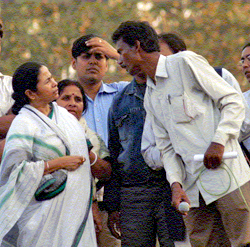Kolkata, Aug 30: West Bengal Chief Minister Mamata Banerjee today said she was not at all worried about the BJP gaining foothold in West Bengal, claiming that a new leadership which believes in riots has come up in the saffron party sidelining veteran leaders like L K Advani and M M Joshi
"Now a new regime has come in the BJP which believes in riots and not in politics. They have sidelined veteran leaders like L K Advani, M M Joshi. They don't give respect to Vajpayeeji," Banerjee said during an interview with a vernacular news channel here.

"I know BJP very well. I had once worked under the leadership of Atal Behari Vajpayee for some time," Banerjee, who was in the BJP-led NDA government, said.
"They know that they cannot reach the people through politics, or social reforms, so they take recourse to violence," Banerjee said.
The TMC supremo claimed that CPI(M) men were getting into BJP fold and were becoming part of its "bhairav bahini".
"They are trying to incite violence and riots in the state. They don't believe in practising politics, they believe in creating divisions through raising communal passion," Banerjee said.
Asked whether she was willing to have alliance with the Left parties, she said, "We can hold talks with them, there is no problem in talking."
Asked whether she is ready to join hands with CPI-M, Banerjee replied, "I did not say that. I only said if any proposal comes, we will discuss in our party."
Taking a jibe at the BJP's pre-election slogan promoting Narendra Modi as the prime ministerial candidate, Banerjee said, "Achche din aney wale hain? bure din aye hain (good days are to come? bad days have come)."
Asked about BJP's aggressive posturing in West Bengal since the Lok Sabha elections, she said, "Let them first get five seats, then they can dream about 294 seats (West Bengal Assembly strength)."
BJP at present does not have any representation in the state Assembly, but has won two Lok Sabha seats out of 42 in the state in the last elections.
"They have got only two seats, one of which is Darjeeling that they had won earlier also and have got one more only, so what is the noise all about?" she asked.
On Lalu-Nitish tie-up to stop BJP in Bihar, Banerjee said, "If such a situation arose in Bengal, we will think over. I still think nobody is untouchable. We had tie-up with SUCI once. We also had tie-up with some other smaller parties. If anybody comes forward we can talk. In a democracy, nobody should shut the door for talks. No option should be closed."





Comments
Add new comment